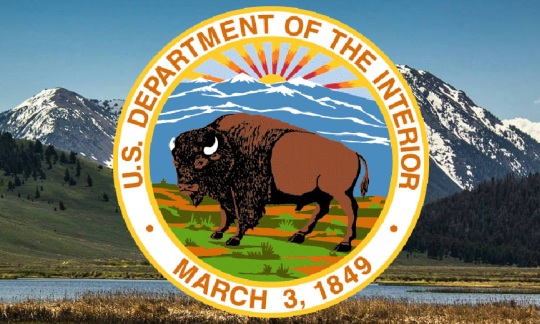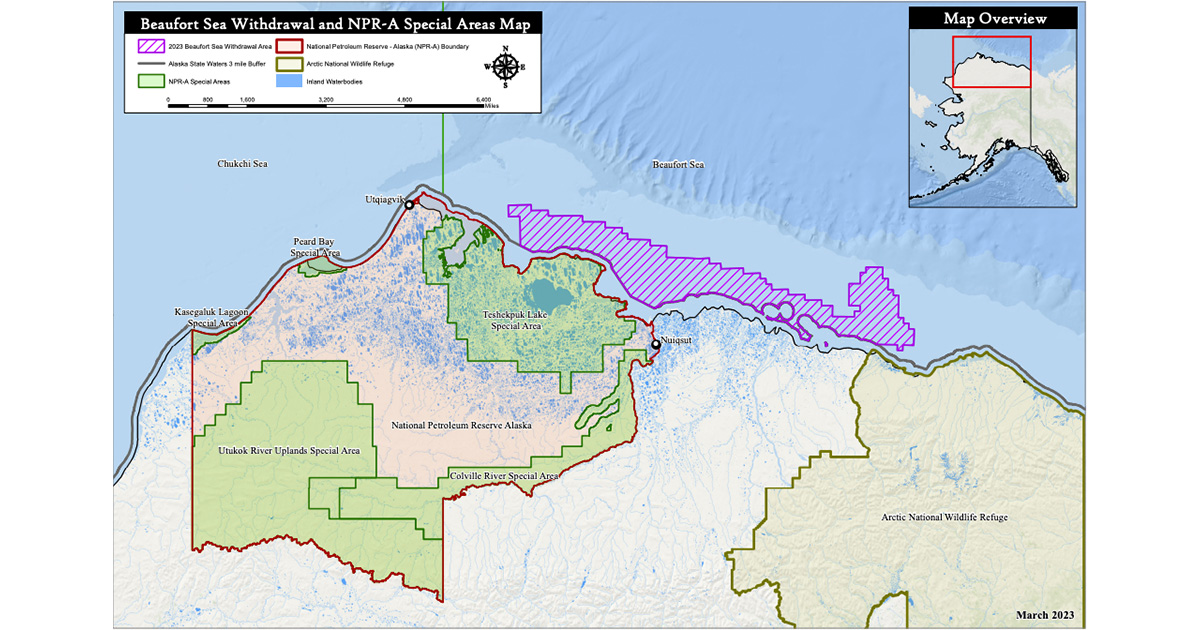The Interior Department issued a Record of Decision regarding the proposed Willow Master Development Plan in the National Petroleum Reserve-Alaska (NPR-A). The Department is substantially reducing the size of the project by denying two of the five drill sites proposed by ConocoPhillips, which is seeking to develop oil and gas leases it acquired beginning in the late 1990s.
The company will also relinquish rights to approximately 68,000 acres of its existing leases in the NPR-A, including approximately 60,000 acres in the Teshekpuk Lake Special Area.
 The Record of Decision denies two of the five drill site pads proposed by ConocoPhillips, reducing the project’s drill pads by 40 percent. The concurrent relinquishment of 68,000 acres by the company of its existing northernmost and southernmost leases within the Bear Tooth Unit reduces the Bear Tooth Unit’s footprint in the NPR-A by one-third. This reduces the project’s freshwater use and eliminates all infrastructure related to the two rejected drill sites, including approximately 11 miles of roads, 20 miles of pipelines, and 133 acres of gravel, all of which reduces potential impacts to caribou migration and subsistence users.
The Record of Decision denies two of the five drill site pads proposed by ConocoPhillips, reducing the project’s drill pads by 40 percent. The concurrent relinquishment of 68,000 acres by the company of its existing northernmost and southernmost leases within the Bear Tooth Unit reduces the Bear Tooth Unit’s footprint in the NPR-A by one-third. This reduces the project’s freshwater use and eliminates all infrastructure related to the two rejected drill sites, including approximately 11 miles of roads, 20 miles of pipelines, and 133 acres of gravel, all of which reduces potential impacts to caribou migration and subsistence users.
The actions will create an additional buffer from exploration and development activities near the calving grounds and migratory routes for the Teshekpuk Lake caribou herd, an important subsistence resource for nearby Alaska Native communities. They significantly scale-back the Willow Project within the constraints of valid existing rights under decades-old leases issued by prior Administrations.
The Biden-Harris administration announced yesterday important steps to limit future industrial development in the NPR-A. First, the Interior Department is initiating a rulemaking to achieve maximum protection for Special Areas in the NPR-A. The proposed rule, which will be available for public comment in the coming months, will consider additional protections for the more than 13 million acres designated as Special Areas in recognition of their importance to wildlife and subsistence uses. The rule would limit future oil and gas leasing and industrial development in the Teshekpuk Lake, Utukok Uplands, Colville River, Kasegaluk Lagoon, and Peard Bay Special Areas—places collectively known for their globally significant intact habitat for wildlife, including grizzly and polar bears, caribou, and hundreds of thousands of migratory birds. The proposed rulemaking would help protect subsistence uses in the NPR-A, responding to Alaska Native communities who have relied on the land, water, and wildlife to support their way of life for thousands of years.
Second, President Biden will take action to designate approximately 2.8 million acres in the Arctic Ocean nearshore the NPR-A as indefinitely off limits for future oil and gas leasing. This action will complete protections for the entire Beaufort Sea Planning Area, building upon President Obama’s 2016 withdrawal under the Outer Continental Shelf Lands Act to protect the Chukchi Sea Planning Area and the majority of the Beaufort Sea. The withdrawal will ensure this important habitat for whales, seals, polar bears, as well as for subsistence purposes, will be protected in perpetuity from extractive development. The withdrawal will provide additional protections for Teshekpuk Lake, guarding against the potential that future Beaufort Sea oil and gas developments would seek to build pipeline infrastructure into the NPR-A.
The Bureau of Land Management (BLM) was required to undertake a review of the proposed Willow project in order to address the flaws identified by the US District Court for the District of Alaska in its August 2021 vacatur of the previous administration’s approval of a project with five drill pads. In February, the BLM published a final supplemental environmental impact statement identifying a preferred alternative that removed one of the five proposed drill pads from consideration and deferred consideration of another.
The BLM consulted with eight cooperating agencies, including the US Fish and Wildlife Service, US Army Corp of Engineers, Inupiat Community of the Arctic Slope, North Slope Borough, State of Alaska, US Environmental Protection Agency, Native Village of Nuiqsut, and City of Nuiqsut, as well as external stakeholders, consistent with the National Environmental Policy Act.
In addition to input from the cooperating agencies, the BLM received substantial input from the public, hosting seven public meetings and receiving more than of 200,000 written comment submissions during the public comment period.
The Record of Decision can be reviewed online here: Willow Master Development Plan project page.
In his first year, President Biden protected more lands and waters than any president since John F. Kennedy. The President and the Biden-Harris administration continue to deliver on the most aggressive climate agenda in American history, including the creation of clean energy manufacturing and jobs. During his presidency, domestic solar panel capacity is on track to increase five-fold next year, electric vehicle sales have tripled, and the number of EV charging ports is up 40%. He has secured record investments in climate resilience and environmental justice. And his economic agenda has put the United States back on track to reach its climate goals for 2030 and 2050 all while reducing America’s reliance on oil.






